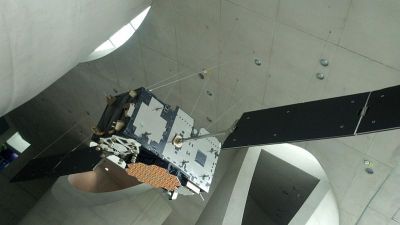Galileo launch brings European navigation system closer to reality

Galileo Sat Model
By Pouyana (Own work) [CC BY-SA 3.0 (http://creativecommons.org/licenses/by-sa/3.0)], via Wikimedia Commons
The launch of two European Space Agency (ESA) Galileo satellites, which took place on 22 August from French Guiana, marks the start of a new phase in Europe’s own satellite navigation programme.
While the launch of both satellites has not gone completely to plan –
there have been confirmed reports of a slight flight path anomaly – both
satellites are under control.
Galileo is an exciting project that will establish Europe’s very own
global satellite navigation system, offering real-time positioning down
to a metre or less. Once complete, the network will consist of 30
satellites and their ground infrastructure, working alongside existing
GPS positioning and the Russian Glonass system.
Given EU estimates that European GDP is reliant on GPS applications
to the tune of €800bn per annum, the project is seen as a vitally
important long term investment in European technology. New businesses
will be able to exploit the precise timing and location data delivered
from orbit.
Furthermore, the availability of the service will be guaranteed
under all but the most extreme circumstances and will inform users
within seconds of any satellite failure. This makes it suitable for
safety-critical applications such as guiding cars, running trains and
landing aircraft. As a further feature, Galileo will provide a global
Search and Rescue (SAR) function; satellites will be equipped with a
transponder, which is able to transfer distress signals from user
transmitters to regional rescue coordination centres.
After each satellite is put into operation, it is capable of
broadcasting a navigation signal valid for users with a combined
Galileo/GPS receiver. There are already receivers on the market that
have this capability. In this way, the Galileo satellite navigation
system is being built up piece by piece.
ESA expects to have the complete (or certainly, nearly complete)
satellite constellation in orbit by 2017. This month’s launch of a Soyuz
rocket carried the fifth and sixth Galileo satellites, with an
estimated six to eight satellites now scheduled for launch each year. To
this end, the agency has just ordered three big Ariane-5 rockets at a
cost of half a billion euros.
With respect to the current flight path of satellites five and six,
ESA says that studies are ongoing to determine the scope of the anomaly
and its impact on the mission. Further information on the status of the
satellites will be made available after a preliminary analysis of the
situation.
ESA is an intergovernmental organisation, created in 1975, with the
mission to shape the development of Europe’s space capability and ensure
that investment in space delivers benefits to the citizens of Europe
and the world. By coordinating the financial and intellectual resources
of its members, ESA can undertake programmes and activities far beyond
the scope of any single European country.
ESA has 20 Member States: Austria, Belgium, the Czech Republic,
Denmark, Finland, France, Germany, Greece, Ireland, Italy, Luxembourg,
the Netherlands, Norway, Poland, Portugal, Romania, Spain, Sweden,
Switzerland and the United Kingdom, of whom 18 are Member States of the
EU. It also has Cooperation Agreements with eight other Member States of
the EU. Canada takes part in some ESA programmes under a Cooperation
Agreement.
published: 2015-01-23

